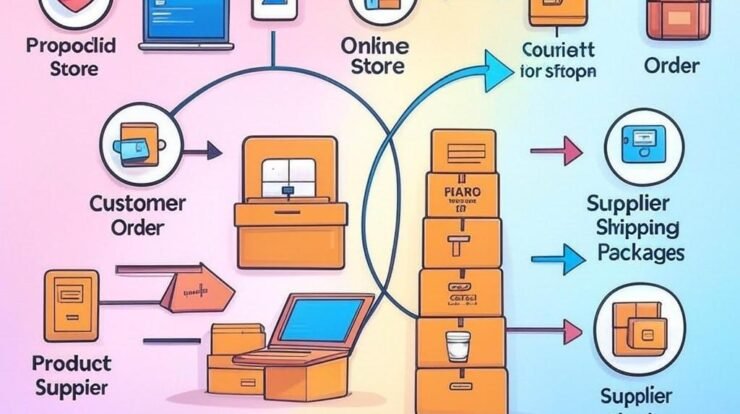The internet has transformed the way we make money, offering countless opportunities to turn passions, skills, and even everyday items into profitable ventures. If you’re wondering, “What can I sell online to make money?” you’re not alone. Entrepreneurs, side hustlers, and creatives worldwide are tapping into the digital marketplace to build sustainable income streams. As someone who’s been in the e-commerce game for years, I’ve seen trends come and go, and I’m here to share actionable, expert-backed ideas to help you start selling online with confidence. This guide dives deep into what you can sell, how to do it effectively, and strategies to stand out in a crowded market.
Why Selling Online Is a Game-Changer

The global e-commerce market is booming, with sales projected to hit $7.4 trillion by 2025, according to Statista. Whether you’re looking to supplement your income or build a full-time business, selling online offers flexibility, scalability, and access to a worldwide audience. From physical products to digital goods and services, the possibilities are vast. But success doesn’t come from throwing random items onto a website and hoping for the best. It requires strategy, research, and a keen understanding of what buyers want.
In this article, we’ll explore a variety of products and services you can sell online, tailored to different skills, budgets, and interests. Whether you’re a creative type, a tech enthusiast, or someone with a garage full of unused items, there’s a niche for you. Let’s dive into the best options for 2025 and beyond.
Physical Products to Sell Online
1. Handmade Goods and Crafts
If you’re crafty, platforms like Etsy and eBay are goldmines for selling handmade goods. From custom jewelry to personalized home décor, buyers love unique, one-of-a-kind items. The key is to niche down—don’t just sell “candles”; sell eco-friendly, soy-based candles with quirky scents inspired by pop culture. For example, a friend of mine started selling hand-poured candles themed around classic novels, and her shop took off because it resonated with book lovers.
Pro Tip: High-quality photos and storytelling in your product descriptions can set you apart. Share the inspiration behind your creations to connect with customers emotionally.
2. Vintage and Secondhand Items
The secondhand market is thriving, driven by sustainability trends and nostalgia. Platforms like Poshmark, Depop, and eBay make it easy to sell vintage clothing, collectibles, or even retro electronics. Got a box of old vinyl records or 90s band tees? Those could be worth hundreds to the right buyer. I once flipped a $5 thrift store typewriter for $150 on eBay because it was a rare model collectors wanted.
Pro Tip: Research trending items using tools like eBay’s “Sold Listings” or Google Trends to see what’s in demand. Clean and stage your items well to justify higher prices.
3. Print-on-Demand Products
Print-on-demand (POD) is a low-risk way to sell custom-designed products like t-shirts, mugs, and phone cases. Services like Printful, Teespring, or Redbubble handle production and shipping, so you focus on creating designs. This is ideal if you’re artistic or have a knack for catchy slogans. For instance, niche designs targeting specific hobbies—like “Cat Mom Yoga” tees—tend to sell better than generic graphics.
Pro Tip: Use social media platforms like Instagram or TikTok to showcase your designs and drive traffic to your store. Hashtags like #PrintOnDemand and #CustomMerch can boost visibility.
4. Dropshipping Products
Dropshipping lets you sell products without holding inventory. You set up an online store, market the products, and a supplier handles fulfillment. Popular niches in 2025 include eco-friendly products, pet accessories, and tech gadgets. Tools like Oberlo or Spocket can help you find reliable suppliers. A colleague of mine built a six-figure dropshipping business by selling ergonomic office supplies during the remote work boom.
Pro Tip: Avoid oversaturated niches like generic phone cases. Instead, focus on underserved markets and use SEO tools like Ahrefs to find low-competition keywords.
5. Subscription Boxes
Subscription boxes are still a hot trend, offering curated experiences delivered monthly. Think beauty products, gourmet snacks, or even niche hobby kits like knitting or board game accessories. The key is to offer value and surprise—customers want to feel like they’re getting more than they paid for. For example, a subscription box for plant enthusiasts with rare seeds and care guides could tap into the growing indoor gardening trend.
Pro Tip: Partner with influencers in your niche to promote your box. A single shoutout from a micro-influencer can drive hundreds of subscribers.
Read more: Exploring Websites That Pay Real Money: Your Guide to Earning Online
Digital Products to Sell Online
6. E-books and Guides
If you’re an expert in a field—whether it’s fitness, finance, or gardening—e-books are a fantastic way to share knowledge and earn passive income. Platforms like Gumroad or Amazon Kindle Direct Publishing make it easy to publish and sell. I know a fitness coach who wrote a 50-page e-book on “Meal Prep for Busy Moms” and now earns $2,000 a month passively.
Pro Tip: Offer a free sample chapter to entice buyers. Optimize your listing with keywords like “how to [your niche]” to improve search rankings.
7. Online Courses and Workshops
The e-learning market is expected to reach $457 billion by 2026, per Research and Markets. If you have expertise in coding, photography, or even mindfulness, platforms like Udemy, Teachable, or Skillshare let you create and sell courses. I’ve seen teachers pivot from in-person tutoring to online courses, scaling their income by reaching students globally.
Pro Tip: Break your course into bite-sized modules and include interactive elements like quizzes or live Q&As to keep students engaged.
8. Digital Art and Graphics
Artists can sell digital downloads like printable wall art, planner templates, or Canva-designed social media kits. Sites like Creative Market and Etsy are perfect for this. A graphic designer I know makes a steady income selling Instagram story templates tailored to small businesses.
Pro Tip: Bundle related items (e.g., a set of 10 planner templates) to increase perceived value and boost sales.
9. Software and Apps
If you’re tech-savvy, developing simple apps or tools can be lucrative. For example, browser extensions for productivity or niche SaaS tools for freelancers are in demand. You don’t need to be a coding genius—low-code platforms like Bubble can help you create apps without extensive programming knowledge.
Pro Tip: Validate your idea by posting on forums like Reddit’s r/Entrepreneur to gauge interest before investing time in development.
Services to Sell Online
10. Freelance Skills
Platforms like Upwork, Fiverr, and LinkedIn are ideal for selling services like writing, graphic design, or social media management. The gig economy is growing, with 36% of U.S. workers freelancing in 2024, according to Upwork. If you have a skill—say, copywriting or SEO—you can start offering it today.
Pro Tip: Build a portfolio website to showcase your work and use testimonials from past clients to establish credibility.
11. Coaching and Consulting
Whether it’s life coaching, business consulting, or career advice, one-on-one services are in high demand. Platforms like Clarity.fm or Coach.me connect you with clients. I know a career coach who charges $150/hour for resume reviews and interview prep, all conducted via Zoom.
Pro Tip: Offer a free 15-minute consultation to attract clients and build trust.
12. Virtual Event Planning
With hybrid events on the rise, virtual event planners are needed for webinars, online conferences, and even digital weddings. If you’re organized and creative, this could be a lucrative niche. Tools like Eventbrite or Zoom make it easy to manage.
Pro Tip: Specialize in a niche, like corporate webinars or gaming tournaments, to stand out.
Read more: Exploring Online Money Earning Jobs for Students: A Personal Journey
Strategies to Succeed in Online Selling
Research Your Market
Before you start, use tools like Google Keyword Planner or Jungle Scout to identify what people are searching for. For example, if you’re selling pet products, search for terms like “best dog toys 2025” to see what’s trending. Understanding your audience’s pain points and desires is crucial.
Build a Strong Brand
Your brand is more than a logo—it’s the story you tell. Create a consistent voice and aesthetic across your website, social media, and product listings. For instance, a minimalist skincare brand might use clean visuals and simple language to appeal to eco-conscious buyers.
Leverage Social Media and Content Marketing
Social platforms like TikTok, Instagram, and Pinterest are powerful for driving traffic. Create short, engaging videos showcasing your products or sharing tips related to your niche. A food blogger I know grew her spice blend business by posting 15-second recipe videos on TikTok, linking to her Shopify store.
Optimize for Search Engines
To rank higher on Google or marketplace searches, use relevant keywords naturally in your product titles, descriptions, and blog posts. For example, instead of “cute mug,” use “handmade ceramic coffee mug for book lovers.” Long-tail keywords like “what can I sell online to make money fast” can also drive targeted traffic.
Provide Stellar Customer Service
Fast shipping, clear communication, and hassle-free returns build trust. I once bought a handmade scarf on Etsy, and the seller included a handwritten thank-you note and a small free gift. That personal touch turned me into a repeat customer.
Challenges and How to Overcome Them
Selling online isn’t without hurdles. Competition is fierce, and platforms like Amazon and Etsy charge fees that can eat into profits. To succeed, focus on differentiation—offer something competitors don’t, like faster shipping or unique customization. Another challenge is staying consistent. Set a schedule for listing new products or posting on social media to keep your audience engaged.
If you’re worried about upfront costs, start small. Use free tools like Canva for design or social media for marketing. As your revenue grows, reinvest in premium tools or advertising to scale.
Read more: Proven Strategies – Earn Money Online $100 a Day – No Fluff, Just Results
Final Thoughts

Selling online is one of the most accessible ways to make money in 2025, whether you’re flipping thrift store finds, designing digital products, or offering your expertise. The key is to start with something you’re passionate about, research your market, and build a brand that resonates with your audience. From handmade crafts to virtual coaching, the opportunities are endless. Pick one idea, test it, and refine your approach based on what works. With persistence and strategy, you can turn “what can I sell online to make money” into a thriving business that fits your lifestyle.
Got a specific skill or product in mind? Drop a comment below, and I’ll share tailored tips to help you get started!





